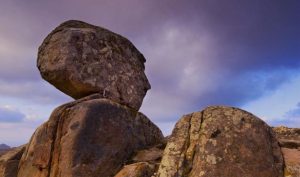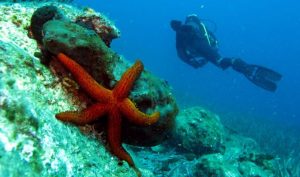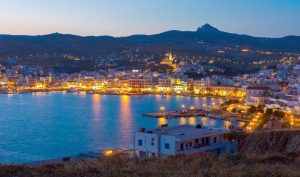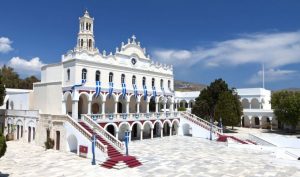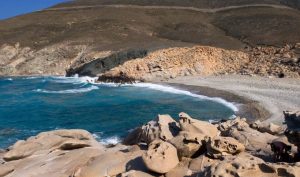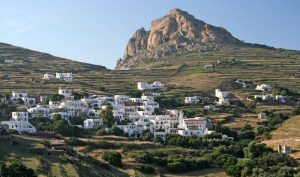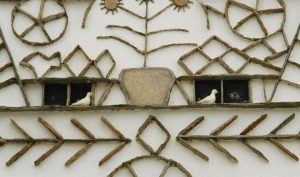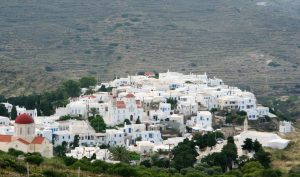
Tinos
Tinos is a Greek island situated in the Aegean Sea. It is located in the Cyclades archipelago. In ancient times, Tinos was also known as Ophiussa (from ophis, Greek for snake) and Hydroessa (from hydor, Greek for water). The closest islands are Andros, Delos, and Mykonos. It has a land area of approximately 194 square kilometres and a 2001 census population of 8,574 inhabitants. It is composed of the municipalities of Tinos (pop. 5,203) and Exomvourgo (2,692) plus the community of Panormos (679).
Between 1207 and 1715, Tinos was in Venetian hands. From 1715 to 1821, Tinos was ruled by the Ottoman Empire before joining with Greece.
Tinos is famous amongst Greeks for: the Church of Panagia Evangelistria, its 80 or so windmills, about 1000 artistic dovecotes, 50 active villages and its Venetian fortifications at the mountain, Exobourgo. On Tinos, both Greek Orthodox and Roman Catholic populations co-exist, and the island is also well known for its famous sculptors and painters, such as Nicholaos Gysis, Yannoulis Chalepas and Nikiforos Lytras.
The island is located near the geographical center of the Cyclades island complex, and because of the Panagia Evangelistria church, with its reputedly miraculous icon of Virgin Mary that it holds, Tinos is also the center of a yearly pilgrimage that takes place on the date of the Dormition of the Virgin Mary (August 15, “Dekapentavgoustos” in Greek). This is perhaps the most notable and still active yearly pilgrimage in the region of the eastern Mediterranean. Many pilgrims make their way the 800 metres from the ferry wharf to the church on their hands and knees as sign of devotion. The day also commemorates the 1940 sinking of the Greek cruiser Elli by an Italian submarine on August 15, 1940 at Tinos’s harbor (see the relevant article). The island’s mineral resources include marble, Verde antico, asbestos and a granite mine near Volakas (also known as Volax).
Hidden gems of Tinos
Immortal Tinian sculptures Legend says that Phidias taught the art of sculpture to the Tinians. And who’s going to argue with legend? At the museums of Tinos – The Cultural Centre of Tinos, The Museum of Marble Crafts and Tinian Artists in Pyrgos – you will admire immortal works of Neohellenic sculpture. Giannoulis Halepas, Dimitris Filippis, the Fitali brothers, Lazaros Sochos and Georgios Vitalis have all left their mark here. Learn the secrets of their art by taking classes at the marble sculpture workshops.
The famous dovecotes: every one a masterpiece Peristeriones are typical to the Tinian landscape, and are some of the most impressive works of art in the Cyclades. There are over 600 dovecotes made of slate, stone and limestone and covered with lithographs. The pigeons and doves swoop around them, but you’ll need a trigger finger on your cameras to catch them in flight!
Tinos: the holy island of the Cyclades Every year, on the 15th of August, thousands of believers descend upon Tinos, to accompany the procession of the miraculous icon. You can hardly make out the icon of Panagia Evangelistria, hidden as it is behind the numerous offerings that surround it. On their knees, pilgrims begin the ascent from the port to the church, overlooking Tinos town since 1880. Be a witness to this miracle of faith.
Volax: a lunar landscape in the Aegean Surrounding the village of Volax is a surrealistic plateau with huge boulders. Like the abandoned toys of a playful giant. The round boulders of all different sizes are hundreds of years old. They are not meteorites, but down to the geological phenomenon of erosion. Experience the wild beauty of this lunar landscape, crossing the region of Kakovolo, from Falatado to Panagia Kaki Skala.
The peak of Exomvourgo Some 640m above sea level, the mountain of Exomvourgo stands out among the island’s landmarks. At its base you will find the Catholic monastery Ieras Kardias (Sacred Heart), one of the most impressive attractions on the island. The fortress of Exomvourgo, at the peak, was once the highest in the Aegean, but it was besieged and destroyed by the Turks in 1715. From up high you can see not only Tinos, but also Samos, Ikaria, Naxos and Delos… breathe in the Aegean!
Hidden gems of Tinos
Trekking Follow the island’s old trails and encounter little miracles; ruins of old settlements, fountains, windmills, chapels and dovecotes, lithographs and green valleys.
Livadia beach This beach stands out because of its sculpture-like rocks and wild water. As you leave the beach, walk as far as the lighthouse at Papargyras, and then around the highest mountain in Tinos, Tsiknia.


